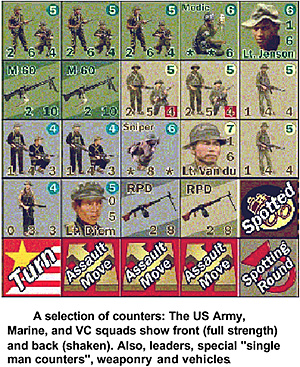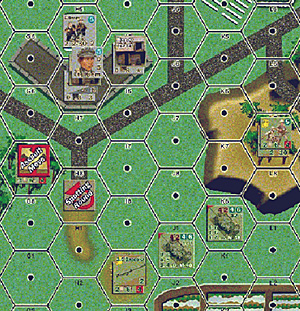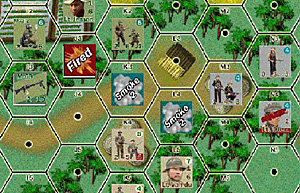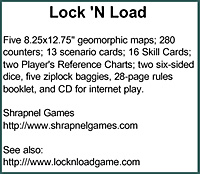 Lock 'N Load packs a squad level view of the
Vietnam War into one impressive package. Not only
are the graphics and presentation superb, the rules
are clever and simple. The first infantry-only game --
Scenario 1: Perfume River (near Hue 1968) -- took
approximately 2 and a half hours from time of cracking
open the box to time of putting everything away. And
that included all the page-flipping normally
associated with learning a new system.
Lock 'N Load packs a squad level view of the
Vietnam War into one impressive package. Not only
are the graphics and presentation superb, the rules
are clever and simple. The first infantry-only game --
Scenario 1: Perfume River (near Hue 1968) -- took
approximately 2 and a half hours from time of cracking
open the box to time of putting everything away. And
that included all the page-flipping normally
associated with learning a new system.
Squad level combat is nothing new. Squad Leader (and I suppose the sequel Advanced Squad Leader) is the classic game of the genre, covering WWII. That, however, is a complex system and the rules run hundreds of pages by the time you include all the modules. It will let you simulate anything in WWII, but you're going to have to invest some time to understand how it works. Lock 'N Load (LnL), on the other hand, needs only 12 pages for the basic infantry game, 9 pages of rules for vehicles, helicopters, artillery, and such, and another 5 to provide detailed examples of play. You still need to invest some time, but certainly not as much as Squad Leader.
Counters, Maps, and Cards
Physically, this is a beautiful game. Counters are illustrations representing squads and half-squads, individual leaders, specific weapons (MGs, RPGs, etc), and vehicles. LnL also contains a number of administrative markers--fired, moved, spotted, wreck, etc. Of note, counters come in three sizes: squads and leaders are 5/8", weapons teams are 3/4", and vehicles are 7/8". Every little bit of ergonomics helps.
The five 8.25x12.75" geomorphic maps use 1" hexes and include a variety of nicely illustrated terrain appropriate to jungle warfare. Each hex equals 50 meters and also includes a centered dot, somewhat detracting from the overall aethetics, but oh so practical for determining line of sight.
 Sixteen characteristic cards are also included (as well as associated administrative counters) which imbue
leaders and stacks containing leaders with bonus modifiers and such. For example, Charismatic allows a leader to
rally squads not only in the same hex as usual, but in adjacent hexes as well. Rage allows a "hero" (special fellow, but
not a leader) +1 firepower point in a melee.
Sixteen characteristic cards are also included (as well as associated administrative counters) which imbue
leaders and stacks containing leaders with bonus modifiers and such. For example, Charismatic allows a leader to
rally squads not only in the same hex as usual, but in adjacent hexes as well. Rage allows a "hero" (special fellow, but
not a leader) +1 firepower point in a melee.
Sequence
Turn sequence is Rally, Move/Shoot, and Clean-Up, with players alternating in the Move/Shoot portion by stack of units. This gives a player pause to decide which attack will best disrupt the enemy because results take effect immediately. Thus, firing is not simultaneous. Firing combat is quick: Roll a d6 and add all the firepower points shooting. The target rolls a d6 and adds terrain bonus. In firing, you want to roll high.
If the firer's total is greater than the defender's total, the defender starts rolling against morale: roll a d6 and add the difference in the totals. If the total exceeds the target's morale, bad things start to happen: squads go shaken, heroes take wounds, etc. If the total is twice the morale, worse things start to happen: squads take casualties, leaders take wounds, soft vehicles become destroyed, etc. In morale rolling, you want to roll low.
It's all pretty quick and points out US firepower advantage. On the other hand, VC opportunity fire and ambush can wrack US forces before they get to fire. It's an interesting game of countermeasures. The most effective troop may very well be the sniper, who rolls 2D6 for firepower and has double the range and gets a free setup on the board.
 A Twist
A Twist
The 13 scenarios (each on a separate 8.5x11" card) include the usual OOBs, map set ups, victory conditions, scenario-specific rules, and so on. However, many of them contain instructions for Event Markers. When a player fulfills a specific condition, such as occupy a position, or cross a line, or have line of sight to a hex, it triggers a "paragraph." These paragraphs are on the back of the card, and presumably, you're smart enough to heed the "DO NOT READ AHEAD" warning and so will get some surprise when one of these events occurs.
Although I have not played all 13 scenarios and looked at all events, a random read of some scenarios' paragraphs indicates that they are often a bad thing for the US--morale checks, booby traps, etc, but that they also contain some good things: artillery fire support and so on. Of course, there are usually victory conditions that force you to read the paragraphs. For example, the victory conditions in one scenario note that the US has to occupy all huts and the wooden building on the map. Sure enough, on the map is ONE wooden building. This particular event has either a grenade attack or a booby trap explode when you occupy the building. See what I mean? It's a bit gimmicky, but still a nice twist for the first-time players.
How Does It Play?
Quickly. The alternating stack movement works well, with each player trying to gain the upper hand by plastering spotted stacks. There's a tendency to create maximum-sized stacks that concentrate firepower because that's what defeats other enemy stacks. Single squads, most with either 1 or 2 firepower points, just don't have the strength to do much damage when the enemy is taking advantage of cover. Put the maximum three squads, a support MG, and a leader in a hex, and now you've got 9 firepower points plus a die roll. The toughest terrain, a stone building, is only 4 points. With average rolls, there's an excellent chance of turning most targets into "shaken" units. Since you can only do one thing (move, fire, spot, throw smoke, etc) with a stack per turn, decision making per turn is also quick. The Marines, NVA, and certain other units are capable of assault movement, which allows half movement and fire or half movement and Opportunity Fire.
Melee is virtually identical to firing (using the same factors), only firepower is expressed as an odds ratio, 2d6 are rolled versus a number on the chart, and hits are kills. You are allowed to gang up on one squad in a hex filled with multiple squads and continue the melee next turn.
Morale plays a large part of the game as you often roll against the number to save your self from fire effects as well as rallying when enemy fire hurts. Most squads are rated 5 or 6, with most leaders a point or two higher. Half morale is also used to spot enemy troops.
 Tripe and Snipe
Tripe and Snipe
Upon gazing at the box cover, my first question was: "Who the hell is Mark Walker?" But then I had to apologize. The question should be: "Who the hell is Mark H. Walker?" His name's on the box, but I have no idea who he is. The marketing gurus at Shrapnel call him an "industry veteran," but fail to tell me what else he has designed. Indeed, there are no previous design credits or even designer's notes in the manual. However, I'm positive Mark's response will be: "Who the hell is Russ Lockwood?" I'm pretty sure your response will be: "Who the hell cares? Is it a good game or not?" It strikes me as odd that his name is plastered across press releases and box covers. Maybe he owns a piece of Shrapnel. Or it must be in the contract to make his name a common one. If he creates more games like LnL, that will undoubtedly become true.
I did notice that Ben Hull is in the credits for "invaluable advice." If this is the same Ben Hull that was in a Marine recon battalion during Desert Storm, you know the game has impeccable support. There's also an endorsement from the National Vietnam Veterans Art Museum in Chicago. I'm not sure what that means, either, but it can't hurt. I don't see much evidence of use of the museum's work. Maybe there's a reason. I prefer not to know.
I have a small nit with the rules: organization could be better. Firepower is explained in section 5.0, but support weapons are in section 1.6. Leaders are explained in section 11.0, but effects of wounded leaders are buried in 5.1. I'm not quite sure why terrain doesn't modify melee. We must have built all those fire bases for some reason, but then again, this game tackles meeting engagements, patrols, and similar sorts of missions in the rural areas, not set-piece battles in bases or cities. LnL has rules for bunkers and foxholes and wire. Oddly enough, in terms of fire combat, I'd rather be in a wooden building (+3 Terrain Die Modifier) than in a fortified bunker (+2). The heavy jungle is also +2 (+3 for VC and NVA). Go figure.
The game also includes a CD that allows two players to play on-line. Since there's a fair bit of interaction on any given turn, I'm not sure that is the best medium to use, but that's your option. As this is a quick first look, I've not experimented with vehicles and helicopters as much, so stay tuned.
Like Squad Leader, LnL will spawn numerous modules. Unlike Squad Leader, these modules will cover the Falklands, Desert Storm, and WWII. There's even a sci-fi module coming, which leads me to ask the question about whether this game system is too generic. If it can be used no matter what the period, bolt-action WWII through laser blaster sci-fi, is this really a Vietnam (or modern-era) system?
 But Is It History?
But Is It History?
Like all historical-based games, the mechanics and factors should reflect historical events. I poked around, asked a few questions of some vets, and came out with the idea that LnL follows the main themes of Vietnam era combat.
The US Army squads are rated as 2 firepower versus US Marines at 3. Historically, the Army used 10-man squads while the marines used 13-man squads.
Regarding firepower, Marines engaged in the unofficial practice of swapping weapons. Marine Corps policy sent a replacement soldier into Vietnam carrying a weapon, and he left Vietnam carrying one too. But no matter what he came with, he tended to leave with a beat-up M-16. As a result, sometimes a squad collected up to three MGs (one per fire team).
In addition, the Army squads have 4 movement points while the Marines have 4 movement points with the assault movement option. This makes sense too, as the Marine tactical response to ambush -- drummed into them via training -- was to immediately face the ambush and empty a magazine in that direction. Then, they would reload and move towards the ambushers firing a burst (3-4 rounds) with each alternate step. They found that ambushes were usually carried out by as few as two VC. Such blind firing -- under the assumption that the VC didn't know the Marines couldn't see them -- worked to suppress the ambushers' fire.
The worst thing to do was to drop and roll away from the fire--the ditch or other side of the trail was usually mined. This comes from a Marine who did a tour there.
One other note, and this comes from an air cav veteran, concerns LAWs (Light Anti-Tank Weapons). Most guys in his outfit ditched them at the first opportunity, believing them not worth the effort to carry and disappointed with their combat results.
Overall
LnL is a quick game. The graphics production is excellent, the rules and game mechanics simple, and the rationale behind counters and factors good. You can crack this open and play a scenario in an evening--and most of us don't have time for all-day epics anymore. Lock 'N Load looks good, plays well, and has enough clever ideas to get my recommendation.
Lock 'N Load
Five 8.25x12.75" geomorphic maps; 280 counters; 13 scenario cards; 16 Skill Cards; two Player's Reference Charts; two six-sided dice, five ziplock baggies, 28-page rules booklet, and CD for internet play.
Shrapnel Games http://www.shrapnelgames.com
See also: http:///www.locknloadgame.com
Back to Cry Havoc! # 46 Table of Contents
Back to Cry Havoc! List of Issues
Back to MagWeb Master Magazine List
© Copyright 2004 by David W. Tschanz.
This article appears in MagWeb.com (Magazine Web) on the Internet World Wide Web. Other articles from military history and related magazines are available at http://www.magweb.com